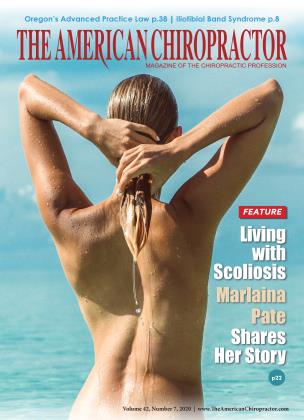Iliotibial Band Syndrome
FEATURE
M. Enrique Flores
DC
Iliotibial band syndrome (ITBS) is a common knee injury we all have seen in our offices. ITBS is usually the result of many factors:
• Poor arch support from your feet.
• Spending long periods sitting in lotus posture in yoga, especially beginners forcing the feet onto the top of the thighs.
• Consistently running on a banked surface, causing extreme stretching of the band against the femur.
• Positioning the feet toe-in to an excessive angle when cycling.
• Hiking long distances.
• Rowing.
• Swimming breaststroke style and treading water..
Understanding the Connection
Let’s do a basic review of the anatomy of the iliotibial band.
The ilotibial band (ITB) is a band of thick connective tissue that runs along the lateral aspect of the thigh. It is a continuation of the tensor fascia lata (TFL), which arises from the iliac crest, the anterior superior iliac spine, and inserts into the layers of the ITB one-third of the way down the thigh.
The gluteus maximus muscle also inserts into the ITB and is innervated by the inferior gluteal nerve (L5S2). The superior part of the ITB splits into two layers to enclose the TFL and tendon of the gluteus maximus muscle. The ITB continues to descend on the lateral surface of the thigh and inserts onto the lateral tibial plateau at a projection known as Gerdy’s tubercle. It moves from behind the femur to the front of the femur during activity and is crucial in stabilizing the knee as it extends the knee and laterally rotates the leg.
The continual rubbing of the band over the lateral femoral epicondyle, combined with the repeated flexion and extension of the knee during activity, may cause the area to become inflamed.
Where’s the Pain?
Diagnosing ITBS is pretty straightforward, based on history and physical exam findings. Symptoms reported by the patient are sharp pain and swelling on the proximo-lateral aspect of the knee. Thickening of the tissue in the area where the band moves over the femur may also be easily identified. Pain is most commonly felt when the foot strikes the ground. It might not occur during activity but may become more intense over time.
Chiropractors are the leading experts in the diagnosis of musculoskeletal and structural imbalances, and, as such, we should pay attention to the following:
• Valgus deformities or tightness in the iliotibial band.
• High or low arches in the feet.
• Supination of the feet.
• Bowing of the Achilles tendon.
• Excessive lower leg rotation due to overpronation.
• Excessive foot strike force.
• Uneven leg lengths.
We should also assess muscle imbalances, such as:
• Weak gluteus medius, gluteus minimus, tensor fasciae latae, and the hip abductor muscles.
• Weak or non-firing multifidus muscle.
• Uneven left-right stretching of the ITB as caused by habits, such as sitting cross-legged.
You Can’t Survive on RICE Alone
Treating acute symptoms of ITBS can be resolved with rest, ice, compression, and elevation, followed by proper stretching to reduce the inflammation. Chronic symptoms, on the other hand, can be a bit more challenging. We know that RICE works, but we know that this does not address the root cause of the problem. One long-term solution to the problem is custom-made orthotics. A great start is scanning your patients’ feet to uncover structural imbalances arising from the feet. After all, the feet are the foundational support of the entire body and can certainly influence alterations in the kinematic chain.
Yes, multiple research studies have been published in numerous reputable journals. However, what I’ve experienced repeatedly is that supporting the feet the right way, i.e., with custom-made orthotics, does make a huge difference for the better. I’ve seen it with my own severe case of ITBS pain due to high-mileage running with cavus feet and hammertoes. I’ve also seen it with a multitude of my patients ranging from the amateur fitness enthusiasts to elite/Olympic-level athletes. I’ve prescribed custom-made orthotics to them and have achieved success in the resolution of their nagging and sometimes very debilitating ITB pain.
References
1. Richards, David P.; Alan Barber, F.; Troop, Randal L. (March 2003). “Iliotibial bandZ-lengthening”. Arthroscopy: The Journal of Arthroscopic & Related Surgery. 19 (3): 326-329. dot: 10.1053/jars.2003.50081. ISSN 07498063. PMID 12627161.
Dr. M. Enrique Flores graduated with honors from the University of Miami and Texas Chiropractic College. He is the former chair of Florida's Department of Health's Worksite Wellness Committee. He has worked with members of Mexico's Olympic team and elite triathletes from Guatemala and Brazil. He is the 2016 Central American gold medalist in the Masters Division for the 10,000 mts event. He has completed dozens of marathons throughout the country, several 50and 100-mile relay races, as well as triathlons up to the Ironman distance.
 View Full Issue
View Full Issue












